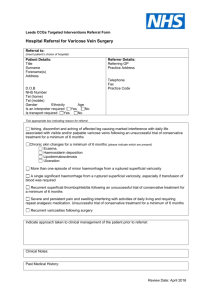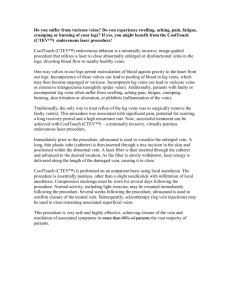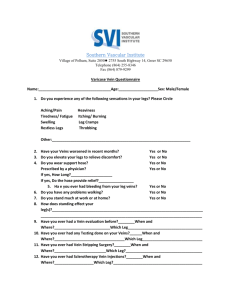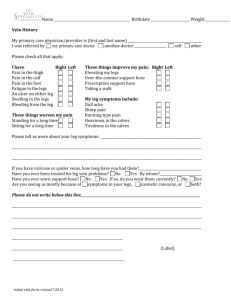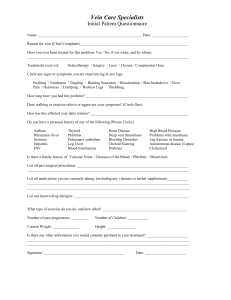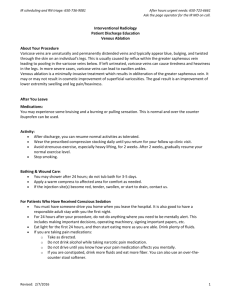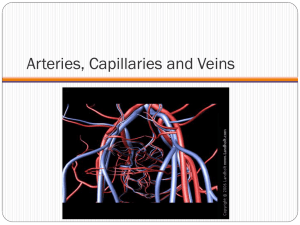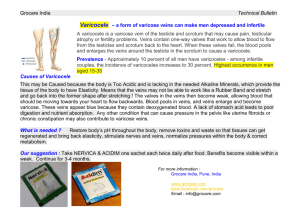4732 Varicose Vein Surgery - Sheffield Teaching Hospital
advertisement
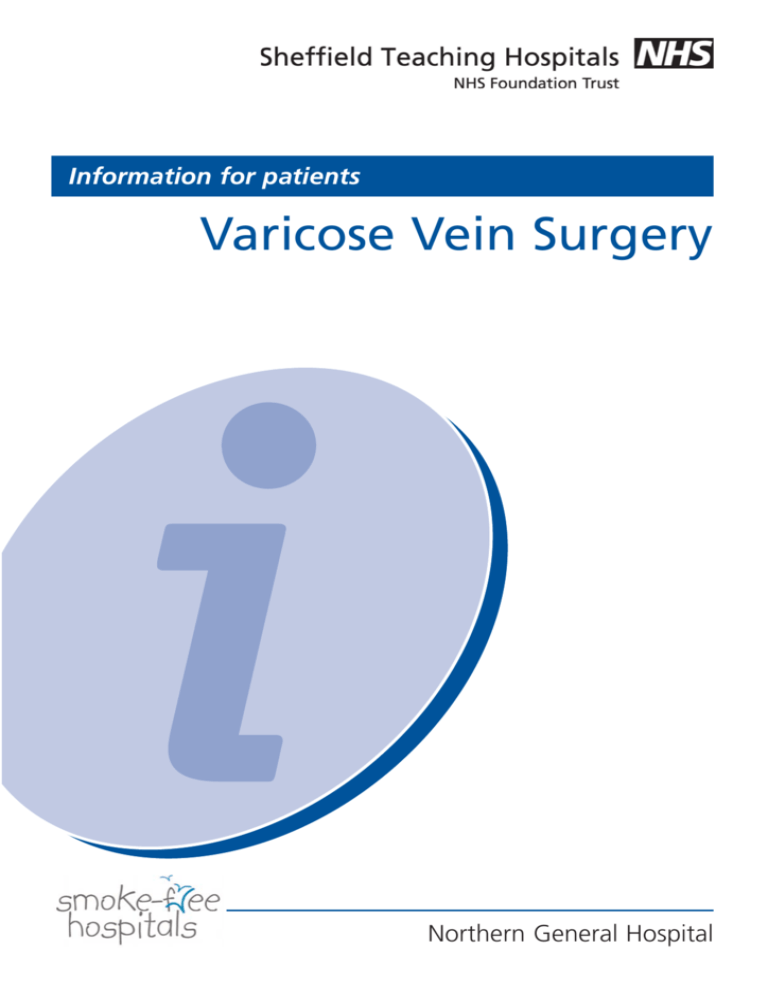
Information for patients Varicose Vein Surgery Northern General Hospital You have been diagnosed as having varicose veins and your specialist has recommended varicose vein surgery. This leaflet explains more about Varicose Vein Surgery and answers some of the most frequently asked questions. If, after reading this leaflet, you have any more questions or concerns, you should write them down and discuss them at your next appointment. Where will my hospital appointments take place? Your appointments will be at the Sheffield Vascular Institute at the Northern General Hospital. Consultants from the Sheffield Vascular Institute also visit Rotherham and Barnsley District hospitals, and some patients are seen at these hospitals. The Sheffield Vascular Institute is one of the largest vascular centres in Europe. We specialise in the treatment of all circulatory conditions affecting the arteries, veins and lymphatics. If you wish to find out more about the Sheffield Vascular Institute then look under the Guide to Services of the Sheffield Teaching Hospitals NHS Foundation Trust website ( http://www.sth.nhs.uk ) Why do I need the operation? You and your surgeon have agreed that an operation to remove your varicose veins is the best option for you. Alternative options will have been discussed by your surgeon and these are: no treatment, compression stockings, injections into the veins (sclerotherapy) or laser treatment. 1 Will I need any tests first? You will usually be seen in the Pre-admission Clinic a few weeks before your surgery. You will have a number of pre-operative checks, including blood tests, to check that you are fit for the operation. How long will I need to be in hospital? Most varicose vein operations are performed as a day case. If you have particular medical problems, or no one at home to look after you, then in patient treatment may be required. In this case, you will usually be admitted on the day of the operation, if a bed is available, and go home the day after. We normally only operate on one leg at a time as a day case, to ensure that the operation does not last too long. Otherwise you might not have enough time to fully recover and go home the same day. Do I need to bring anything in particular with me? Please bring all the medicines you are taking in to hospital with you. You will also need to bring glasses or hearing aid, if you wear them. If you are staying in over night, then you should bring toiletries and nightwear too. We do ask that you bring a supply of your own clothing into hospital. However, we do advise that you leave valuables and cash at home, with the exception of a small amount of cash for you to purchase newspapers and other items, or to pay to use the patient-line system. 2 Before your operation Before the operation, the surgeon will check all the necessary preparations have been made and check that you are happy to go ahead with the operation. The surgeon will also mark your varicose veins with a felt tip pen. You will also be seen by the anaesthetist who will discuss the anaesthetic with you. Most varicose vein operations are performed under a light general anaesthetic. A spinal anaesthetic is sometimes an alternative. If you are going to have a cut in the groin, hair in this area will need to be removed. You do not need to shave yourself, as this is best done with an electric clipper immediately before your operation. You should have nothing to eat for 6 hours before the operation; but you can have clear fluids, for example water, up to 4 hours before the operation. This is because an empty stomach is important for a general anaesthetic. How is it done? A small cut is made over the top of the main varicose vein in the groin and it is tied off just where it joins the deep vein. This is called a saphenofemoral disconnection. The cut is closed with stitches which are hidden under the skin and dissolve by themselves. The main vein under the skin in the thigh is stripped out. This helps to reduce varicose veins forming again. Blood flows up the deeper veins in the leg after this vein has been removed. The varicose veins marked before the operation are removed through tiny cuts (multiple avulsions). These cuts are usually closed with adhesive strips. 3 Other veins with connections to the deep veins may also need to be tied off, in particular one behind the knee. This is called a saphenopopliteal disconnection. At the end of the operation, the leg is wrapped up in an adhesive compression bandage to reduce the amount of bruising. How long does the operation take? The operation normally takes about one hour. What happens after the operation? Pain relief: People vary a lot in the amount of pain they experience after the operation, though most experience discomfort only. We inject a long acting local anaesthetic into the groin wound during the operation, which greatly reduces any pain you might feel. Pain killers will be prescribed for you to take after the operation. If you experience any pain you should ask the nurse for these while in hospital. You should take them yourself at home if you are uncomfortable. You should not need to take them for more than a few days, but the duration of discomfort does vary from person to person. Day patient: After two or three hours, you should feel fit enough to go home. Before you leave the nurses will check your leg. They will give you a note for your GP and some painkillers to take home with you. You will also be given an advice sheet. Please feel free to ask any questions about anything you did not understand. Staff from the day surgery unit will telephone you the day after your operation to check that you are alright. You need to make an appointment with the practice nurse at your GP’s surgery 7 days after the operation. This is to remove the bandages and check that your wounds have healed. 4 Inpatient: You will usually be able to get up within a few hours of the operation, once the nurses have checked your legs. You will be able to go home as soon as you and the doctors agree you are well enough and walking, usually on the day after the operation. You will be given a note for your GP and some painkillers to take home with you. You need to make an appointment with the practice nurse at your GP’s surgery 7 days after the operation. This is to remove the bandages and check that your wounds have healed. Are there any risks? Nerve damage: Damage to the small nerves that supply feeling to the skin is quite common (1 in 10 risk - 10%), as these can be cut or stretched when the varicose veins are removed. This may result in a patch of numbness and tingling, especially around the ankle. The affected area often becomes smaller with time. Damage to the major arteries, veins and nerves in the leg have all occurred during varicose vein operations. These are very rare complications, which we take great care to avoid. Operations behind the knee have a very small risk of foot drop due to nerve damage (less than 1 in 100 risk - 1%). This problem usually improves as nerve function returns. Deep vein thrombosis: A blood clot in the deep veins (DVT) is a complication of any operation, but is very uncommon after varicose vein surgery (less than 1 in 100 risk - 1%). You will be given an injection of heparin at the time of the operation if you have an increased risk of DVT. 5 Heparin makes the blood clot less than normal but it does increase the amount of bruising. If you are taking the contraceptive pill, your risk of thrombosis is increased. Please discuss the pros and cons of stopping the pill, or continuing it and having heparin, with your surgeon or GP. Other complications: Wound problems, such as infection and bruising, can occur after varicose vein surgery but are rarely bad enough to need antibiotic treatment or drainage (1 in 50 risk - 2%). Tenderness and inflammation of any veins left behind (phlebitis) can be treated with antiinflammatory gel. Thread veins can sometimes develop at the site of scars or bruising. What happens after I have gone home? Wounds and bruising: Sometimes a little blood will ooze from the wounds during the first 12 - 24 hours after the operation. The amount is likely to be very small and the bleeding usually stops on its own if you elevate the leg. If necessary, press on the area for ten minutes with a pad of paper tissue. If the bleeding continues after doing this twice, phone the Day Surgery Unit, the Ward or your GP according to the advice sheet that you have been given. If you cannot contact anyone, then come to the Accident and Emergency Department. It is usual for the wounds to feel tender and thickened for several weeks due to the normal healing process. Bruising and lumpiness is common after varicose vein operations and may take a month or more to disappear. 6 Dressings and stitches: We may use dressings in the groin or behind the knee and, if there is one, it can normally be taken off after 2 - 3 days. After this time, the wounds can be washed gently with soap and water. Avoid talcum powder for the first few days. The stitches under the skin do not have to be removed as they will simply dissolve. The small cuts further down the leg are closed with adhesive strips. You should not bathe or shower for 7 - 10 days, unless you can do so without getting the adhesive bandages wet. After this time, the district nurse will remove the bandages and adhesive strips. This is often easiest after a bath or shower, which helps to loosen them. A simple adhesive plaster can be applied to any cut that is not quite healed. Bandages and stockings: The bandages on the leg that had the operation will be removed after 7 days by your practice nurse. After this, you should wear a support stocking on this leg for a further 2 weeks. You will already have been given a similar stocking to wear on the other leg (non-operated) to start wearing on the day of the operation, and to continue for 3 weeks. These stockings should be kept on day and night. You can stop wearing the stockings on both legs 3 weeks after the operation. 7 How long before I can resume normal activities? You can start to walk about as soon as you have recovered from the anaesthetic. Getting up the next day is sometimes a little uncomfortable, particularly when the groin has been operated on. Take the painkillers if you need them. You will not damage any of the wounds by walking. You should aim to walk at least twice a day for the first week or two. Frequent walking is more important than walking long distances. This often simply means getting back to your normal routine as rapidly as possible. You can go to the gym but avoid strenuous exercise until the bandages have been removed. When you are not walking try and put your foot up, otherwise your foot will swell. Is there any activity that I should avoid doing? You should not drive while you have any discomfort, or the bandages are in place as they may affect your ability to drive. Do not return to work for two weeks if this requires prolonged sitting, standing or heavy manual work. You should not take long-haul flights for one month. Will my varicose veins come back? Some people develop new varicose veins but this is uncommon after thorough surgery (10% risk after 10 years). If varicose veins develop again they can be treated with injections or further surgery should they become troublesome. You can help to avoid them by taking regular exercise and avoiding excessive weight. 8 What if I think there is something wrong when I get home? If you think that there is something wrong with your wound or abdomen (tummy) once you get home, you should contact: • The Bev Stokes’ Day Surgery Unit Monday to Friday (8am - 6pm) • Firth 2 0114 2266020 0114 2714602 / 2714685 9 Sheffield Teaching Hospitals supports organ donation. Do you? This information can be made available on request in alternative formats including Braille, large print, audio, electronically and other languages. For further details email: alternativeformats@sth.nhs.uk © Sheffield Teaching Hospitals NHS Foundation Trust 2010. Re-use of all or any part of this document is governed by copyright and the “Re-use of Public Sector Information Regulations 2005” SI 2005 No.1515. Information on re-use can be obtained from the Information Governance Department, Sheffield Teaching Hospitals. Email infogov@sth.nhs.uk PD4732-PIL1357 V2 Issue date: July 2010. Review date: July 2012

